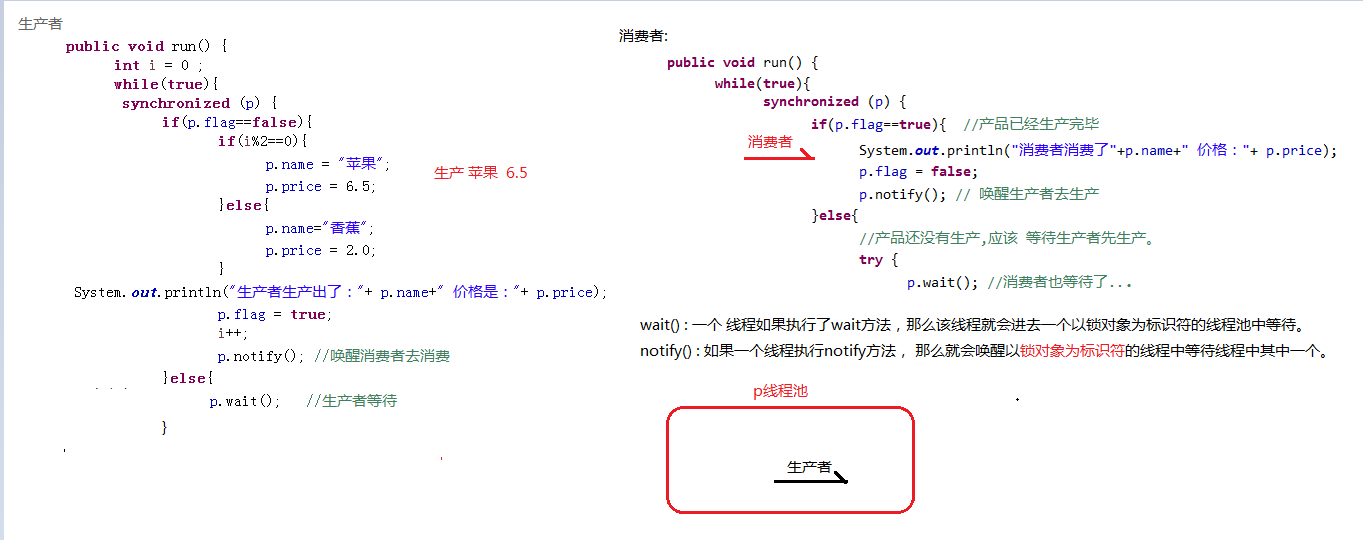package cn.itcast.thread; /* 线程通讯: 一个线程完成了自己的任务时,要通知另外一个线程去完成另外一个任务. 生产者与消费者 wait(): 等待 如果线程执行了wait方法,那么该线程会进入等待的状态,等待状态下的线程必须要被其他线程调用notify方法才能唤醒。 notify(): 唤醒 唤醒线程池等待线程其中的一个。 notifyAll() : 唤醒线程池所有等待 线程。 wait与notify方法要注意的事项: 1. wait方法与notify方法是属于Object对象 的。 2. wait方法与notify方法必须要在同步代码块或者是同步函数中才能 使用。 3. wait方法与notify方法必需要由锁对象调用。 问题一:出现了线程安全问题。 价格错乱了... */ //产品类 class Product{ String name; //名字 double price; //价格 boolean flag = false; //产品是否生产完毕的标识,默认情况是没有生产完成。 } //生产者 class Producer extends Thread{ Product p ; //产品 public Producer(Product p) { this.p = p ; } @Override public void run() { int i = 0 ; while(true){ synchronized (p) { if(p.flag==false){ if(i%2==0){ p.name = "苹果"; p.price = 6.5; }else{ p.name="香蕉"; p.price = 2.0; } System.out.println("生产者生产出了:"+ p.name+" 价格是:"+ p.price); p.flag = true; i++; p.notifyAll(); //唤醒消费者去消费 }else{ //已经生产 完毕,等待消费者先去消费 try { p.wait(); //生产者等待 } catch (InterruptedException e) { e.printStackTrace(); } } } } } } //消费者 class Customer extends Thread{ Product p; public Customer(Product p) { this.p = p; } @Override public void run() { while(true){ synchronized (p) { if(p.flag==true){ //产品已经生产完毕 System.out.println("消费者消费了"+p.name+" 价格:"+ p.price); p.flag = false; p.notifyAll(); // 唤醒生产者去生产 }else{ //产品还没有生产,应该 等待生产者先生产。 try { p.wait(); //消费者也等待了... } catch (InterruptedException e) { e.printStackTrace(); } } } } } } public class Demo5 { public static void main(String[] args) { Product p = new Product(); //产品 //创建生产对象 Producer producer = new Producer(p); //创建消费者 Customer customer = new Customer(p); //调用start方法开启线程 producer.start(); customer.start(); } }

1.没有wait时,notify执行不受影响
2.执行wait时,会释放锁对象。
多线程练习题:
package cn.itcast.thread; class Pooll { /** * 1:有一个水池,水池的容量是固定 的500L,一边为进水口,一边为出水口. 要求,进水与放水不能同时进行. * 水池一旦满了不能继续注水,一旦放空了,不可以继续放水. 进水的速度5L/s , 放水的速度2L/s * * @param args */ int capacity = 0; } // 进水 class Feedwater extends Thread { Pooll p; public Feedwater(Pooll p) { this.p = p; } @Override public void run() { while (true) { synchronized (p) { // 任意类型的对象 ,锁对象应该是同一个对象 if ((p.capacity + 5) <= 500) { System.out.println("进水中,水池容量为:" + (p.capacity + 5)); p.capacity += 5; p.notify(); } else { System.out.println("水池水满了"); try { p.wait(); } catch (InterruptedException e) { e.printStackTrace(); } } } } } } // 出水 class Outwater extends Thread { Pooll p; public Outwater(Pooll p) { this.p = p; } public void run() { while (true) { synchronized (p) { // 任意类型的对象 ,锁对象应该是同一个对象 if ((p.capacity - 2) >= 0) { System.out.println("水池出水中,水池容量为:" + (p.capacity - 2)); p.capacity -= 2; p.notify(); } else { System.out.println("水池没水了"); try { p.wait(); } catch (InterruptedException e) { e.printStackTrace(); } } } } } } public class Pool { public static void main(String[] args) { Pooll p = new Pooll(); Feedwater in = new Feedwater(p); Outwater out = new Outwater(p); in.start(); out.start(); } }